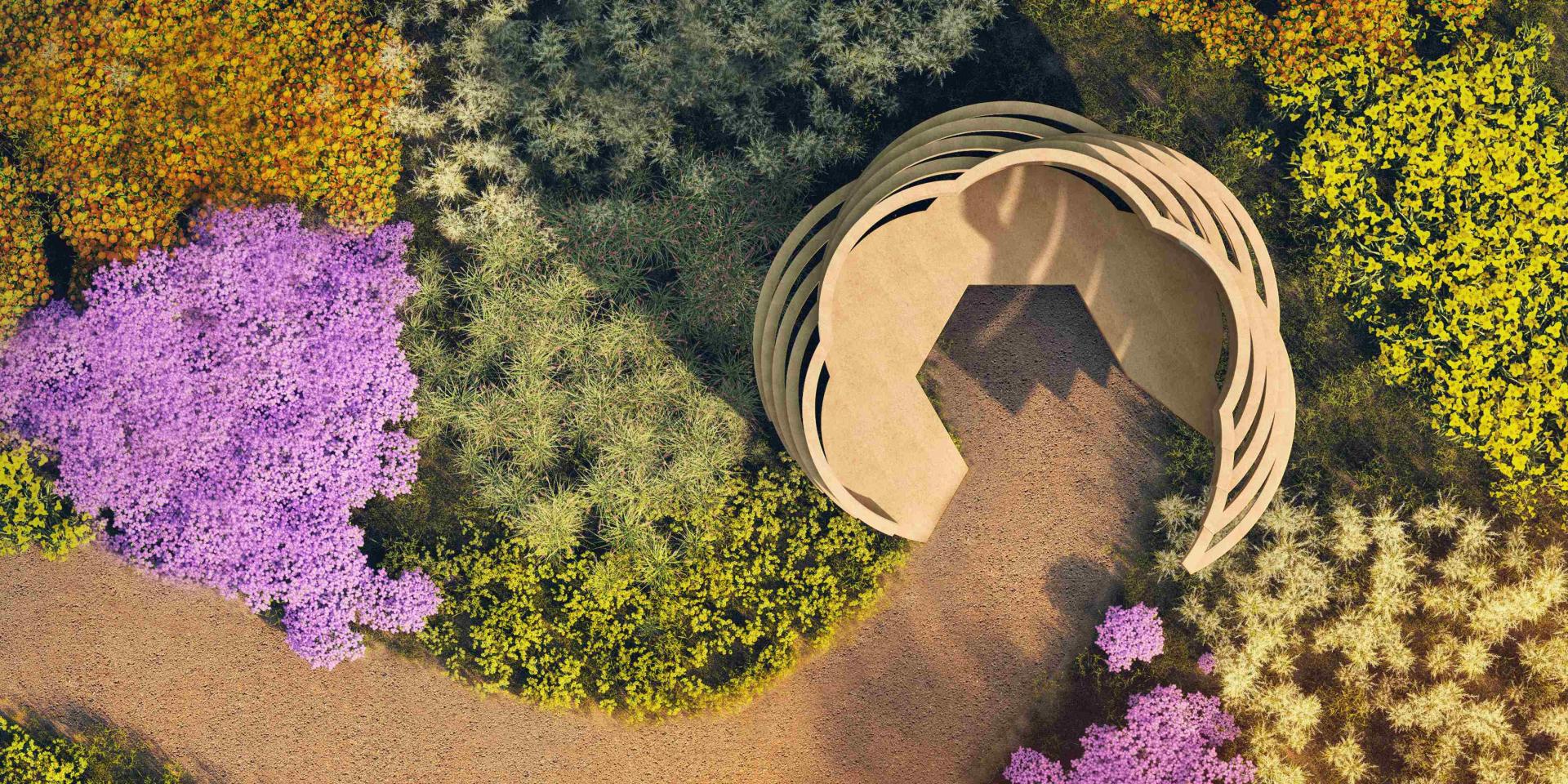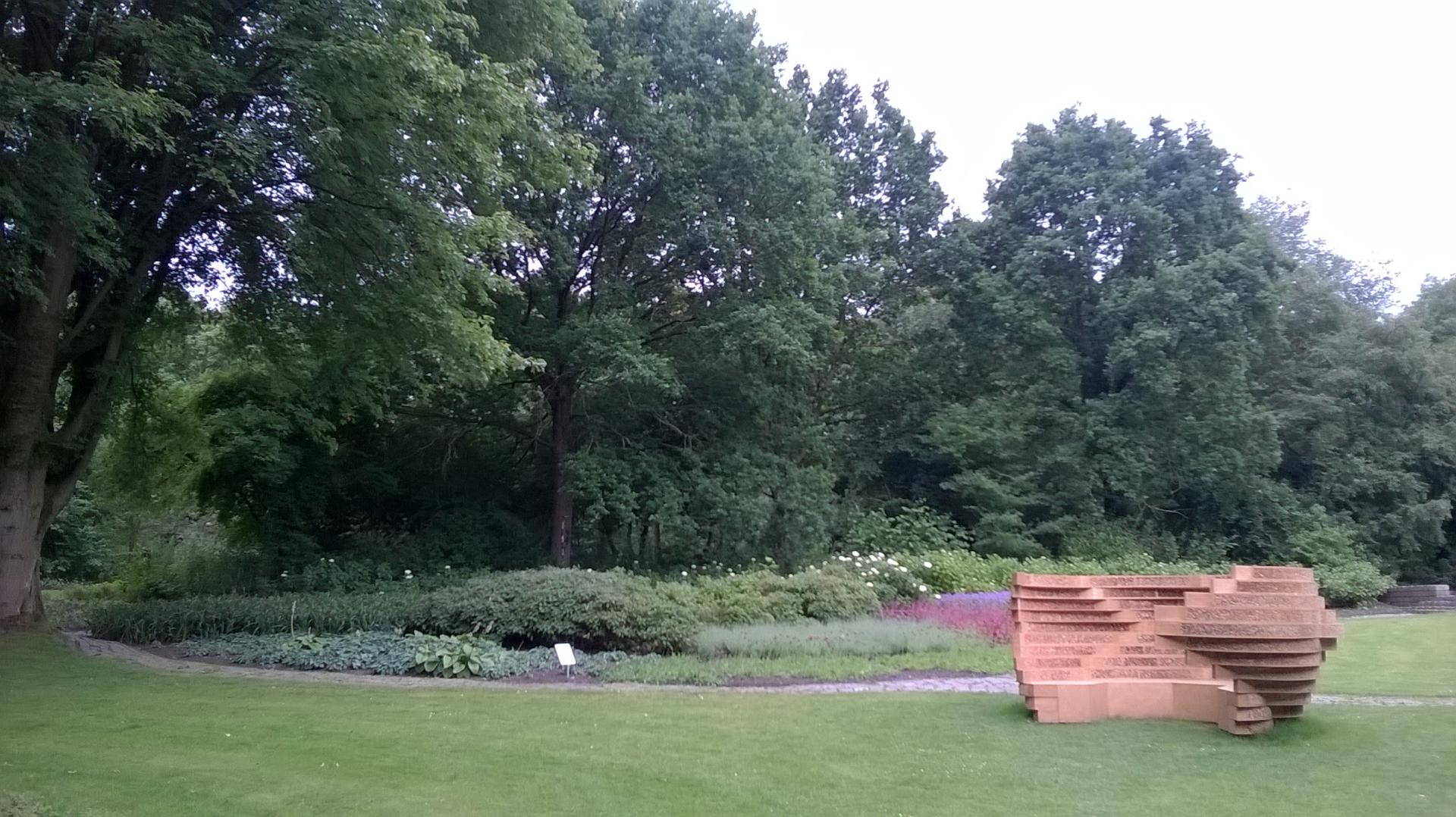Buzzbench
Basic information
Project Title
Full project title
Category
Project Description
The Buzzbench is a monumental habitat for wild bees and at the same time a sculptural parkbench that offers humans an educational opportunity or a quiet retreat to experience an increased sense of perception.
We tend to keep our distance from insects because we are afraid to get stung. But actually, the chances you get attacked by solitairy bees are nil. They are even better pollinators than honeybees and if we dare to take a closer look, they are amazingly beautiful!
Project Region
EU Programme or fund
Description of the project
Summary
The Buzzbench is a biotope for wild bees and at the same time it 's a monumental parkbench that offers humans an educational opportunity or a quiet retreat. The bench is based on geometrical shapes of flowerpetals; the layers are digitally cut and each rotated progressively in 10 degree increments.
Once seated, attention is drawn to the changing patterns of light come through the overlapping layers. The stems offer insects individual tunnels to make sealed cells filled with an egg and a foodpacket.
The egg becomes a larva, then a bee that eats the food, opens the door and flies away. Plenty of flowers to fourage for nectar and pollen in the Amstelpark, a magical place with a huge variety of buildings, plants and creative gardening layouts, due to the fact that it was originally built for the Floriade in 1972.
With the Buzzbench I’d like to create a new public space that will bring our sensory perception to a higher level. The visitor can enjoy colours and smells and look at the view in a new framework.
The shell shape of the bench will change and intensify the humming sounds of bees and hoverflies. The bench embraces and shelters those inside and wraps the visitor into an atmosphere of quiet concentration. Engraved names on the bench are of crowdfunders.
Key objectives for sustainability
I harvested bamboo and cane in gardens and allotments around Amsterdam and experimented a long time how to sandwich these natural materials between boards. I found a relative new, fully recyclable product, acetylated wood panels called Medite Tricoya Extreme, that kept in remarkable good condition. Also I experimented for ways to make the cane more durable by adding wax and tung oil. After some years I had found the perfect recipe.
Key objectives for aesthetics and quality
In my work as a visual artist, an ordening by mathematical patterns or modules, fluid curves that recall nature and architecture, and use of tactile materials is characteristic. In 2014 I had an idea for a small pavillion. It looked interesting but I was looking for a way to add an extra layer to it, something you actually wouldnot expect with a sculpture. I envisioned a sculpture in a natural surrounding, an atmosphere, a special place in the public realm that would bring our sensory perception to a higher level.
My sculptural artworks in the public domain have an autonomous quality, yet often can simultaneously be used in different ways. In this way I arrived at a spatial form that is sculpture, bench and in its own structure consists of thousands of small spaces that offer nesting opportunities for bees.
The sculpture is based on geometrical shapes of flowerpetals; the layers are digitally cut and each rotated progressively in 10 degree increments. It's a monumental, poetic and inviting sculpture, a combination of computer controlled work and manually crafted materials and meticulous manual labour.
Key objectives for inclusion
A cityparc is visited by all kind of people, all kind of nationalities, of all ages. In a parc people have time to stop and talk, it is different than a gallery in the city. In Amstelpark regular visitors are elderly and handicapped who live in special care nearby. The bench is wheelchair accessible. The aspect of inclusion is incorporated in the design by its inviting shape and healing atmosphere. I have noticed that people of different background, different ages, experience and expertise, and different ways of working and points of view seem to connect easily with it. The fluid shapes seem to bring them together almost in a poetic way.The shell shape of the bench absorbes the spectator with an embrace in an atmosphere of silent concentration. It's a meetingpoint.
Results in relation to category
Reinvented places to meet and share
My biggest pride in the project is that it has become a very loved and well known place in the parc that is well used by both people and wild bees. A sculpture that doubles as a bench as a beebiotope. It is a place to contemplate as well as a conversationstarter and point of departure in park excursions. The Buzzbench is part of the Amsterdam "Bee Ribbon", a series of initiatives to promote the bee's chances of survival. These can include gardens or landscapes with bee-friendly plants or, like the Buzzbench, bee hotels. It is nesting help for 12 species of wild bees in the Amstelpark. Plenty of beefriendly flowers to fourage for nectar and pollen are especially planted by the parkgardeners in its near surroundings, as bees have a limited fly area.
How Citizens benefit
This project helped to spread information about solitary bees. As children we are taught to stay away or kill them, but they don't sting because they don't have to defend honey or a nest. These wild bees are crucial for the biodiversity and pollination of our crops. I hope to have contributed to a higher awareness on this important topic.
Innovative character
Innovative is that the Buzzbench has an autonomous quality as an artwork, yet can simultaneously be used in different ways.The Buzzbench is an autonomous sculpture that doubles as a sitting bench as well as a bee biotope.
Also new is the concept to share your environment so close to wild bees. That idea seemed to appeal to people and attracted internationally interest and donors. Leading digital magazines in the field of sustainable design and landscape architecture. like Treehugger, Inhabitat and AasArchitecture, wrote an article. “Urban sculpture to boost wild bee populations: “One can imagine the Buzzbench becoming an educational tool or architectural apparatus for national parks, botanical gardens or other institutions " ( Kimberley Mok in Treehugger), “Support the Urban Biotope Buzzbench to Help Save Wild Bees in Amsterdam (Inhabitat), “Park Bench Designed To Make People And Bees Become Friends” (interview voor Co. Exist, world changing ideas and innovation)
The Buzzbench is also one of the nature art projects in the publication Stadsnatuur maken / Making Urban Nature, an inspirational book about nature-inclusive designing in European cities. The book calls for the integration of the nature in the designs of buildings and urban outdoor spaces and includes practical examples and design suggestions. The authors are members of De Natuurlijke Stad, a collaboration of architects, biologists and urban ecologists. The authors see nature as an integral part of the urban organism and as such as important to the quality of life in the city.
RESULTS LEARNINGS OUTSIDE


